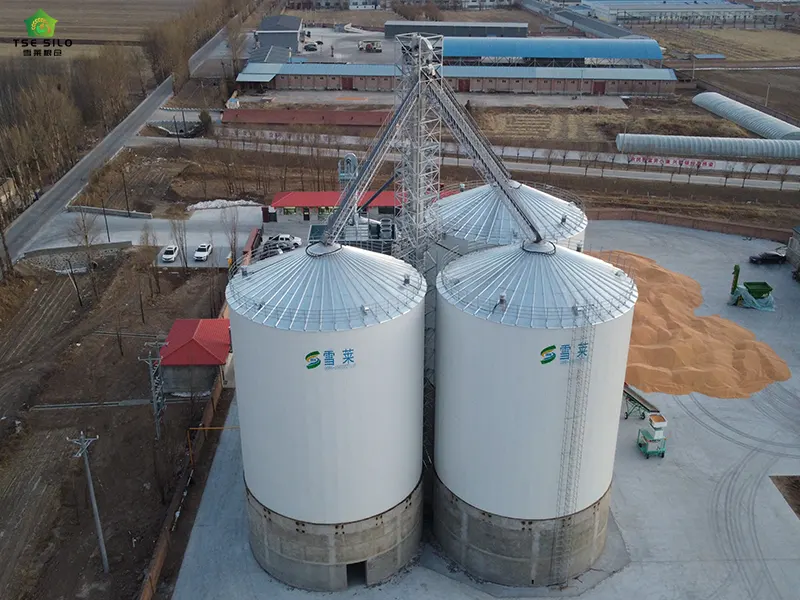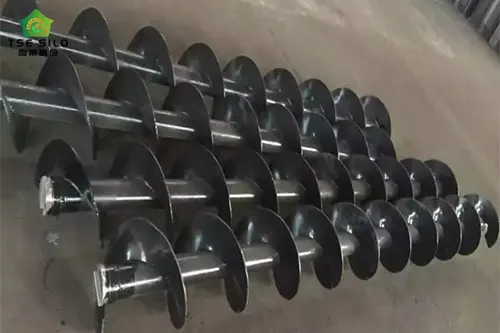When building a steel silo, material selection is a key link in determining its performance, life, safety and economy. In addition to the core galvanized steel plate selection, many factors need to be considered comprehensively. For example, the steel structure responsible for bearing weight, the screws and seals responsible for sealing stability, etc. are all very critical. Today we will explain to you the technical guide for selecting raw materials for building grain steel silo.
1. Selection of steel plate substrate:
- Material and strength: Select the appropriate steel grade and strength grade (such as Q235B, Q355B, etc.) according to the design load of the steel silo (including material static pressure, wind load, snow load, earthquake load, etc.). Insufficient strength will cause structural instability or deformation, and excessive strength will cause waste.
- Thickness: The thickness of the steel plate needs to be accurately calculated and determined based on the height, diameter, material density and design pressure of the silo. Usually, the lower part of the silo wall bears the greatest pressure and has the highest thickness requirement, which can be gradually thinned upwards (variable cross-section design). The silo top, cone bucket, reinforcement ribs and other parts also need to select the corresponding thickness according to the force conditions. Insufficient thickness can cause bulging, deformation, or even explosion; excessive thickness will increase unnecessary costs and weight.
- Specifications and tolerances: Ensure that the width and length of the purchased steel plate meet the design requirements, and the thickness tolerance is within the allowable range to ensure the accuracy of rolling and installation.


2. Steel structure materials (core anti-corrosion):
2.1 Advantages of using galvanized steel plates
2.1.1 Excellent anti-corrosion performance (core reason):
- Sacrificial anode protection of zinc: The chemical properties of zinc are more active than iron. When the galvanized layer is damaged or the edge of the steel plate is exposed, zinc will preferentially undergo oxidation reaction (rust), thereby protecting the underlying steel substrate from corrosion. This protection mechanism is still effective even if there are slight scratches or damage on the surface of the galvanized layer.
- Physical barrier effect: The galvanized layer forms a dense, continuous metal zinc coating on the surface of the steel plate, which effectively isolates the steel substrate from the external environment (oxygen, moisture, electrolyte), preventing electrochemical corrosion of steel.
- Long-term durability: The galvanized layer provides excellent long-term anti-corrosion protection, greatly extending the service life of the steel silo. This is essential for storage facilities that are exposed to outdoor environments (wind, sun, rain, industrial atmosphere, coastal salt spray, etc.) for a long time.
2.1.2 Reduce maintenance costs:
- Due to the excellent anti-corrosion ability of galvanized steel sheets themselves, under normal use conditions, steel silos usually do not require or greatly reduce regular anti-corrosion maintenance work (such as repainting) during their service life. This significantly reduces long-term operating and maintenance costs.
2.1.3 Economic and cost-effective:
- Although the initial material cost of galvanized steel sheets is higher than that of ordinary carbon steel sheets, considering their ultra-long service life and extremely low maintenance costs, steel silos built with galvanized steel sheets are generally more cost-effective throughout their life cycle. Frequent anti-corrosion treatment costs and downtime losses caused by maintenance are eliminated.
2.1.4 Convenience of processing and construction:
- Galvanized steel sheets are galvanized in the factory, and the quality is stable and controllable.
- After the materials arrive at the site, they can be directly processed and installed by rolling, bending, bolting or welding (pay attention to protecting the weld area). There is no need to carry out cumbersome and difficult-to-control anti-corrosion operations such as sandblasting, rust removal, and painting at the construction site, which simplifies the construction process and shortens the construction period.
2.1.5 Protection of stored materials:
- For steel silos that store grain, feed, food raw materials and other materials, it is a basic requirement to prevent steel from rusting and contaminating materials. The galvanized layer is stable and non-toxic (in accordance with relevant standards for food contact materials), which can effectively prevent rust from mixing into the materials and ensure the purity and safety of the materials.
- The surface of the galvanized layer is relatively smooth, which helps the materials (especially powdered or granular materials) to flow smoothly and reduce wall hanging and residue.
2.1.6 Strong adaptability:
- Galvanized steel sheets can adapt to a variety of climates and environmental conditions, from dry inland areas to humid and rainy coastal areas, and even industrial areas with slight chemical pollution, and can provide reliable protection.
2.2 Quality and specifications of galvanized steel sheets
- Zinc layer adhesion/thickness: This is a key indicator of anti-corrosion life. According to the corrosiveness of the environment where the steel silo is located (C1-C5 grades, such as inland rural areas, industrial areas, coastal areas, high humidity, high salt spray, etc.), select the galvanizing amount that meets international/national standards (such as double-sided 275g/m², 350g/m², 450g/m² or Z100, Z200, Z275, etc.). The worse the environment, the thicker the zinc layer required.
- Galvanizing process: Hot-dip galvanizing process is preferred, which has a thick zinc layer, strong bonding and long life. Pay attention to the uniformity of the zinc layer, surface finish, and whether there are defects such as leakage, sagging, and nodules.
- Galvanizing standards: Ensure that the galvanized sheets provided by the supplier meet the relevant quality standards (such as GB/T 2518, ASTM A653/A653M, EN 10346, etc.).
3. Additional protection for special environments and materials:
- Highly corrosive environments/materials: In extreme environments (such as strong acid and alkali atmospheres, heavy salt spray) or when storing highly corrosive materials, the galvanized layer alone may not be enough. Need to consider:
- Higher zinc layer: such as more than 450g/m² on both sides.
- Alloy coating: such as Galvalume (aluminum-zinc alloy coating, 55% Al-Zn), its heat resistance and corrosion resistance (especially cut corrosion resistance) are better than pure zinc in some environments.
- Coated steel sheet: High-performance anti-corrosion coating (such as PVDF, SMP, HDP, etc.) is applied to the galvanized sheet to form a "galvanized + color coating" double protection system (color coating warehouse), which greatly improves weather resistance and decorativeness.
- Stainless steel lining/composite plate: For storing food, medicine or materials with extremely high anti-corrosion requirements, stainless steel lining or galvanized-stainless steel composite plate can be used in key contact parts or as a whole.
- High temperature environment/material: Long-term high temperature will accelerate the consumption of the zinc layer. It is necessary to use Galvalume with better high temperature resistance or consider heat-resistant coating. For silos storing high-temperature materials, special attention should be paid to the thermal deformation and strength attenuation of the material.
4. Material selection of structural connectors and accessories:
- Bolts, nuts, and gaskets: Hot-dip galvanized parts or stainless steel parts that match the anti-corrosion grade of galvanized steel plates must be used to prevent the connection points from becoming corrosion weaknesses. Avoid using ordinary carbon steel bolts.
- Sealants: The sealants used for bolt holes and joints must have excellent weather resistance, elasticity, adhesion, long-term stability, and be compatible with the galvanized layer. Special silicone sealants are a common choice.
- Reinforcement ribs, flanges, and silo roof structural parts: their material, strength, and anti-corrosion treatment (usually hot-dip galvanizing) must be coordinated with the silo wall panels and meet the structural requirements of the corresponding parts.
- Door frames, ladders, and platforms: galvanized materials or materials with equivalent anti-corrosion treatment are also required to ensure consistent overall anti-corrosion life.
5. Special considerations for welding areas:
- Welding damages the galvanized layer: The welding process will burn the galvanized layer near the weld, creating corrosion hazards.
- Post-weld anti-corrosion treatment: The weld and heat-affected zone must be strictly treated with post-weld anti-corrosion. Common methods include:
- Spraying zinc-rich primer (cold galvanizing paint) + topcoat.
- Use a special post-weld repair zinc paste/spray.
- Ensure that the coating thickness and adhesion meet the anti-corrosion requirements. This is the focus of material selection (matching anti-corrosion materials) and construction technology.
6. Material compatibility and food safety:
- Surfaces in contact with materials: If grain, food, feed, medicine, etc. are stored, the galvanized layer and any coating must comply with relevant food safety contact material standards (such as China GB 4806.10, EU EU 10/2011, US FDA CFR 21, etc.) to ensure non-toxicity and no migration pollution risk.
- Coating type: Choose a food-grade special coating that meets the standards.


7. Economic efficiency and life cycle cost:
- Initial cost vs. maintenance cost vs. service life: Don't just look at the initial price of the material. Evaluate the total cost of different anti-corrosion solutions (pure galvanizing, galvanizing + color coating, stainless steel, etc.) throughout the design life cycle, including maintenance, repair and replacement costs. Generally, high-quality anti-corrosion materials with slightly higher initial investment can significantly reduce later maintenance costs and downtime losses, and are more economical.
- Avoid "over-design" and "under-design": Material selection must accurately match project requirements and environmental conditions to achieve optimal cost under the premise of safety and reliability.
8. Supplier qualifications and quality control:
- Qualified suppliers: Select steel plate suppliers with good reputation, relevant production qualifications and quality assurance systems.
- Quality certification documents: Strictly review and retain steel material certificates, galvanizing quality reports, coating test reports (if any), etc.
- On-site inspection: Perform appearance inspection (surface defects, zinc layer condition), size measurement (thickness, width), and random inspection (zinc layer thickness, adhesion, etc.) on the incoming steel plates when necessary.
Summarize the key material selection principles:
- 1. Anti-corrosion first: Determine the amount of zinc/aluminum-zinc layer adhesion of the core steel plate (galvanized or galvanized) according to the environmental corrosiveness and expected life. This is the cornerstone of material selection.
- 2. Strength guarantee: According to the structural calculation, select a substrate of suitable material and thickness to ensure structural safety.
- 3. Detail matching: The anti-corrosion level of all connectors, accessories, and post-weld treatment materials must be consistent with the main material.
- 4. Special response: For extreme environments and special materials (corrosive, high temperature, food grade), take additional protective measures (higher zinc layer, color coating, stainless steel, etc.).
- 5. Compliance: Meet the requirements of relevant regulations such as food safety and environmental protection.
- 6. Full-cycle cost: Comprehensively consider the initial investment and long-term maintenance costs, and pursue the best cost-effectiveness.
- 7. Controllable quality: Strictly control the supplier qualifications and material on-site inspection.
During the project design phase, all the above factors should be fully evaluated, and close communication should be carried out with material suppliers, design units and construction units to formulate the best material selection plan and technical specifications.
The above is the technical guide for selecting raw materials for building grain steel silo. We hope that the above explanation can be helpful to you when building grain steel silos in the future. After all, grain steel silos are grain storage equipment. Whether from the perspective of bearing capacity or ensuring food safety, we must be strict and cautious in material selection. Don't ruin a 10,000-ton grain steel silo because of a screw.
Written by
Shandong Shelley Grain Steel Silo Co., Ltd
Editor Jin
www.grainstoragesilos.com
WhatsApp : +86-18653877118
Email : shelley@cnshelley.com






